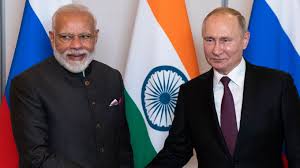By Subrata Majumder
Narendra Modi’s visit to Russia on July 8 and 9, the first since Ukraine war, carries major significance. India’s shifting of oil dependence from OPEC to Russia opens a new chapter of economic relation between the two nations, after it was subdued with the breakdown of Soviet Union in 1991. Apart from defence and political security, India-Russia partnership extended to oil energy cooperation – a signal for revival of economic cooperation between the two countries.
Amidst the global turbulence of oil energy, dictated by OPEC, Russia played critical role in shaping the global energy outlook, in the wake of western sanctions. While sanction became bane to the growth of European economy, it became boon to India. Had Russia refrained from supplying oil to India in the wake of sanctions, it would have been near impossible for India to achieve high growth in the economy. No doubt, Modi’s visit underscored tensions in India’s relations with the U.S. but the gains made by India far outweighed the projected benefits expected by New Delhi from Washington.
Another important outcome of Modi’s visit to Russia was timely counter balancing of Russia- China deepening relation, which worried India. Putin’s choosing China for his first visit after his new term for Russian Presidentship echoed threat to India. This raised eyebrows of the Indian policy makers predicting changes in the foreign policy in the burgeoning Russia- China relationship.
Given the triangular dynamic relationship between India-Russia- China, a study of Chinese documents argued that China has no reason to get worried, owing to India’s bulk purchases of military hardware from Russia, as otherwise, it might have led India shifting to USA and west for military hardware. Today, nearly more than 70 percent military hardware of India are purchased from Russia.
A new era of India-Russia relation has emerged, simultaneously with the global oil sanctions on Russia. It has become the biggest crude oil supplier to India, from a mere supplier two years back. In 2023-24, Russia supplied more than one third of crude oil imported into India. Nearly 35.8 percent of crude oil import was made from Russia in 2023-24, against 1.9 percent in 2021-22.
Inflation and oil price are closely intertwined. The fundamental difference between Russia and OPEC for crude oil supply is, while imports from Russia did not incur any major impact on inflation, imports from OPEC used to be corollary to higher inflation in the country. Hitherto, whenever OPEC prices of oil were hiked, inflation was skyrocketing. In contrary, imports from Russia played a key role in circumventing inflation and helped policy makers to tinker the growth in progressive trajectory.
For example, since imports of oil from Russia surged, petrol and diesel prices plateaued. During three years period of 2021-22 to 2023-24, while oil imports from Russia increased by 1,830.2 percent, (sharing 35.8 percent of total oil imports in 2023-24) against 1.9 percent in 2021-22, inflation by CPI index gyrated within 5.5 percent to 5.4 percent during the same period. This is known as inflation in comfortable zone to achieve 7 percent growth. Inflation increased marginally by 5.5 percent in 2022-23 and by 5.4 percent in 2023-24.
Russian oil was cheaper than OPEC prices. Given the surge in Russian oil supply, average prices of imported crude oil in the Indian basket declined by 11.1 percent in 2023-24. It was against increase by 17.6 percent in the preceding year. This demonstrates that Russian crude prices were the main stake to insulate India from the hikes in petrol and diesel prices.
This opens a new era of relation between oil price hike and inflation in India. With the intervention of Russian oil supply, India has become immune to the global oil turbulence and has nudged down the impact of oil on inflation.
Eventually, low inflation geared up demand in the country. Rise in demand pushed GDP growth in the country. Simultaneously, it has collateral impact on manufacturing. Manufacturing growth in GDP, which was loitering at low ebb, sparked. In GDP growth trajectory, first time after COVID 19, manufacturing had a sparkling growth. It increased by 9.9 percent in 2023-24, against fall by 2.2 percent in the preceding year.
Cheap oil led petroleum products are competitive in world markets. Eventually, Russian oil became the main base for India’s manufacturing of cheap oil refinery products and exports. India imports crude oil, refines them domestically and exports refinery products, such as petrol, diesel, ATF and others. Export of petroleum products is the major product group in India’s export basket. It accounts for nearly 20 percent of India’s total export.
Both in terms of growth trajectory and share in exports, petroleum refinery products are topping in the export basket. For example, while all other major export items exhibited a normal growth in between 8 to 10 percent, petroleum refinery products increased by 44.5 percent in 2022-23 y-o-y basis.
In sum, Russia emerged a new partner of India with a new dimension for both in economy and political friendship, amidst the tension of Russia-China relation. To this end, Modi’s first visit to Russia after Putin’s new term as well as near to the US election had been a big success. (IPA Service)


